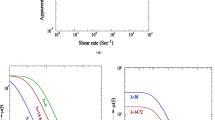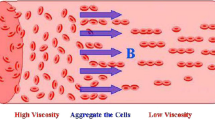Abstract
Two different non-Newtonian models for blood flow are considered, first a simple power law model displaying shear thinning viscosity, and second a generalized Maxwell model displaying both shear thinning viscosity and oscillating flow viscous-elasticity. These models are used along with a Newtonian model to study sinusoidal flow of blood in rigid and elastic straight arteries in the presence of magnetic field. The elasticity of blood does not appear to influence its flow behavior under physiological conditions in the large arteries, purely viscous shear thinning model should be quite realistic for simulating blood flow under these conditions. On using the power law model with high shear rate for sinusoidal flow simulation in elastic arteries, the mean and amplitude of the flow rate were found to be lower for a power law fluid compared to Newtonian fluid for the same pressure gradient. The governing equations have been solved by Crank-Niclson scheme. The results are interpreted in the context of blood in the elastic arteries keeping the magnetic effects in view. For physiological flow simulation in the aorta, an increase in mean wall shear stress, but a reduction in peak wall shear stress were observed for power law model compared to a Newtonian fluid model for matched flow rate wave form. Blood flow in the presence of transverse magnetic field in an elastic artery is investigated and the influence of factors such as morphology and surface irregularity is evaluated.
Similar content being viewed by others
Abbreviations
- τ:
-
wall shear stress
- γ:
-
shear rate
- τγ :
-
yield stress
- ηc :
-
Casson viscosity
- k :
-
the consistency index
- n :
-
non-Newtonian index
- τ p :
-
shear stress of thepth element
- ω:
-
angular velocity
- R :
-
vessel's radius
- C :
-
wave speed
- M :
-
magnetic parameter (Hartmann number)
- u, w :
-
velocity component in ther- andz-directions, respectively
- P :
-
pressure
- α:
-
unsteadiness parameter
- \(\bar k,\bar R\) :
-
mean parameters
- T p :
-
relaxation time of thepth element
- ρ:
-
density
References
Thurston G B. Rheological parameters for the viscosity, visco-elasticity and thixotropy of blood[J].Biorheology, 1979,16:149–155.
Liepsch D, Moravec S. Pulsatile flow of non-Newtonian fluid in distensible models of human arteries[J].Biorheology, 1984,21:571–583.
Rindt C C M, Van de Vosse F N, Van Steenhoven A A,et al. A numerical and experimental analysis of the human carotid bifurcation[J].J Biomechanics, 1987,20:499–509.
Nazemi M, Kleinstreuer C, Archie J P. Pulsatile two-dimensional flow and plaque formation in a carotid artery bifurcation[J].J Biomechanics, 1990,23(10):1031–1037.
Rodkiewicz C M, Sinha P, Kennedy J S. On the application of a constitutive equation for whole human blood[J].J Biomechanical Engg, 1990,112:198–204.
Boesiger P, Maier S E, Kecheng L,et al. Visualisation and quantification of the human blood flow by magnetic resonance imaging[J].J Biomechanics, 1992,25:55–67.
Perktold K, Thurner E, Kenner T. Flow and stress characteristics in rigid walled compliant carotid artery bifurcation models[J].Medical and Biological Engg and Computing, 1994,32:19–26.
Sharma G C, Kapoor J. Finite element computations of two-dimensional arterial flow in the presence of a transverse magnetic field[J].International J for Numerical Methods in Fluid Dynamics, 1995,20:1153–1161.
Dutta A, Tarbell J M. Influence of non-Newtonian behavior of blood on flow in an elastic artery model[J].ASME J Biomechanical Engg, 1996,118:111–119.
Lee R, Libby P. The unstable atheroma[J].Arteriosclerosis Thrombosis Vascular Biology, 1997,17:1859–1867.
Korenaga R, Ando J, Kamiya A. The effect of laminar flow on the gene expression of the adhesion molecule in endothelial cells[J].Japanese J Medical Electronics and Biological Engg, 1998,36: 266–272.
Rachev A, Stergiopelos N, Meister J J. A model for geometric and mechanical adaptation of arteries to sustained hypertension[J].J Biomechanical Engg, 1998,120:9–17.
Rees J M, Thompson D S. Shear stress in arterial stenoses: a momentum integral model[J].J Biomechanics, 1998,31:1051–1057.
Tang D, Yang C, Huang Y,et al. Wall stress and strain analysis using a three-dimensional thick wall model with fluid-structure interactions for blood flow in carotid arteries with stenoses[J].Computers and Structures, 1999,72:341–377.
Zendehbudi G R, Moayary M S. Comparison of physiological and simple pulsatile flows through stenosed arteries[J].J Biomechanics, 1999,32:959–965.
Berger S A, Jou L D. Flows in stenotic vessels[J].Annual Review of Fluid Mechanics, 2000,32: 347–384.
Botnar R, Rappitch G, Scheidegger M B,et al. Hemodynamics in the carotid artery bifurcation: a comparison between numerical simulation and in vitro MRI measurements[J].J Biomechanics, 2000,33:137–144.
Stroud J S, Berger S A, Saloner D. Influence of stenosis morphology on flow through severely stenotic vessels: implications for plaque rupture[J].J Biomechanics, 2000,33:443–455.
Sharma G C, Jain M, Kumar A. Finite element Galerkin approach for a computational study of arterial flow[J].Applied Mathematics and Mechanics (English Edition), 2001,22(9):1012–1018.
Milnor W R.Hemodynamics[M]. 2nd edition. Williams and Wilkins, Baltimore, 1989.
White K C. Hemo-dynamics and wall shear rate measurements in the abdominal aorta of dogs[D]. Ph D Thesis, The Pennsylvania State University, 1991.
Dutta A, Wang D M, Tarbell J M. Numerical analysis of flow in an elastic artery model[J].ASME J Biomechanical Engg, 1992,114:26–32.
Patel D J, Janicki J S, Vaishnav R N,et al. Dynamic anisotropic viscoelastic properties of the aorta in living dogs[J].Circulation Research, 1973,32:93–98.
Author information
Authors and Affiliations
Additional information
Communicated by ZHOU Zhe-wei
Rights and permissions
About this article
Cite this article
Kumar, A., Varshney, C.L. & Sharma, G.C. Performance modeling and analysis of blood flow in elastic arteries. Appl Math Mech 26, 345–354 (2005). https://doi.org/10.1007/BF02440085
Received:
Issue Date:
DOI: https://doi.org/10.1007/BF02440085




